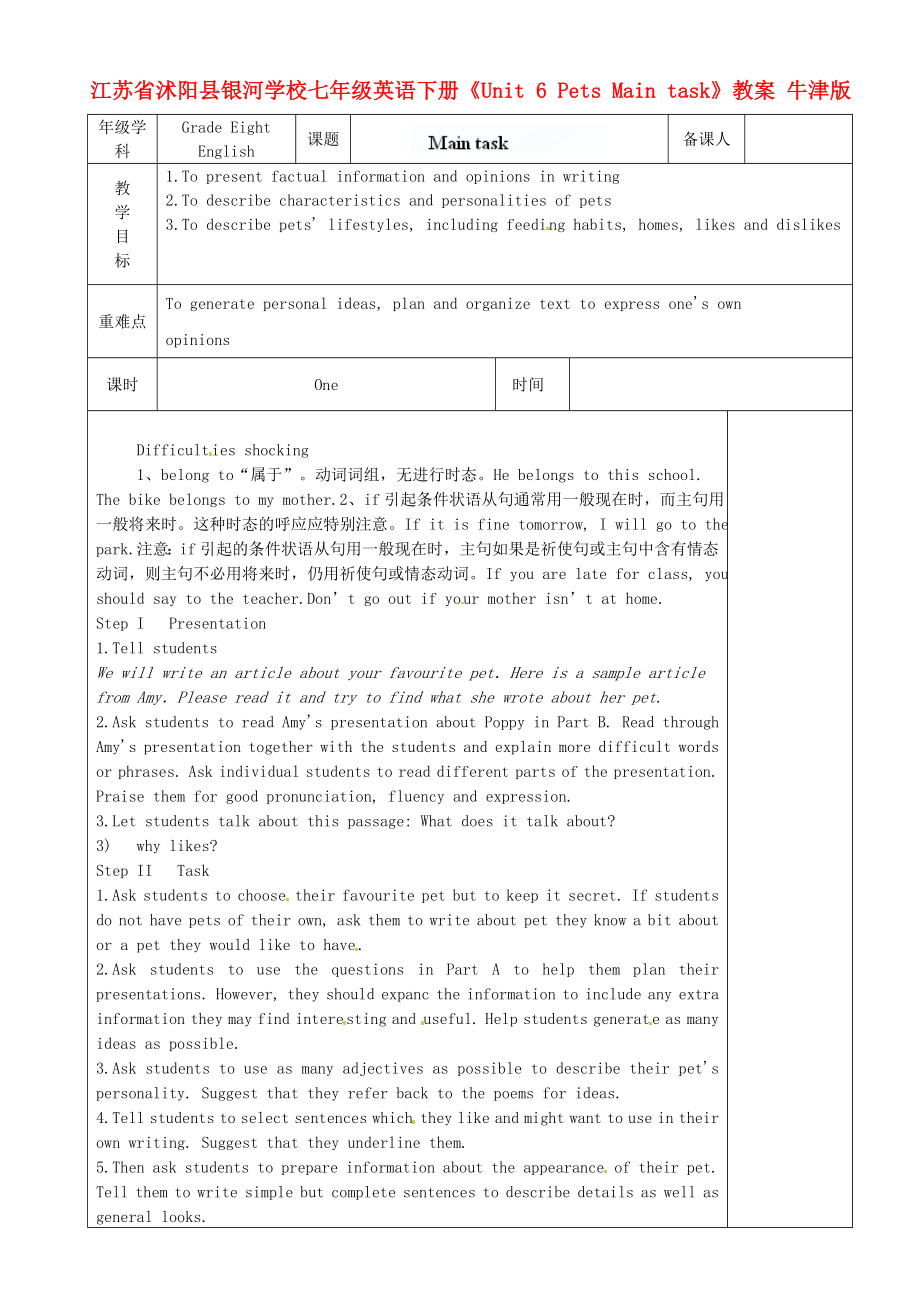《江蘇省沭陽(yáng)縣銀河學(xué)校七年級(jí)英語(yǔ)下冊(cè)《Unit 6 Pets Main task》教案 牛津版》由會(huì)員分享���,可在線閱讀,更多相關(guān)《江蘇省沭陽(yáng)縣銀河學(xué)校七年級(jí)英語(yǔ)下冊(cè)《Unit 6 Pets Main task》教案 牛津版(2頁(yè)珍藏版)》請(qǐng)?jiān)谘b配圖網(wǎng)上搜索��。
1��、江蘇省沭陽(yáng)縣銀河學(xué)校七年級(jí)英語(yǔ)下冊(cè)《Unit 6 Pets Main task》教案 牛津版
年級(jí)學(xué)科
Grade Eight
English
課題
備課人
教
學(xué)
目
標(biāo)
1.To present factual information and opinions in writing
2.To describe characteristics and personalities of pets
3.To describe pets' lifestyles, including feeding habits, homes, likes and dislikes
2�����、
重難點(diǎn)
To generate personal ideas, plan and organize text to express one's own
opinions
課時(shí)
One
時(shí)間
Difficulties shocking
1、belong to“屬于”����。動(dòng)詞詞組,無(wú)進(jìn)行時(shí)態(tài)�。He belongs to this school.
The bike belongs to my mother.2、if引起條件狀語(yǔ)從句通常用一般現(xiàn)在時(shí)���,而主句用一般將來(lái)時(shí)�。這種時(shí)態(tài)的呼應(yīng)應(yīng)特別注意����。If it is fine tomorrow, I will go to the
3、park.注意:if引起的條件狀語(yǔ)從句用一般現(xiàn)在時(shí)��,主句如果是祈使句或主句中含有情態(tài)動(dòng)詞����,則主句不必用將來(lái)時(shí),仍用祈使句或情態(tài)動(dòng)詞���。If you are late for class, you should say to the teacher.Don’t go out if your mother isn’t at home.
Step I Presentation
1.Tell students
We will write an article about your favourite pet.Here is a sample article
from Amy.Please r
4�、ead it and try to find what she wrote about her pet.
2.Ask students to read Amy's presentation about Poppy in Part B. Read through Amy's presentation together with the students and explain more difficult words or phrases. Ask individual students to read different parts of the presentation. Praise t
5、hem for good pronunciation, fluency and expression.
3.Let students talk about this passage: What does it talk about?
3) why likes?
Step II Task
1.Ask students to choose their favourite pet but to keep it secret. If students do not have pets of their own, ask them to write about pet they know
6����、 a bit about or a pet they would like to have.
2.Ask students to use the questions in Part A to help them plan their presentations. However, they should expanc the information to include any extra information they may find interesting and useful. Help students generate as many ideas as possible.
7、3.Ask students to use as many adjectives as possible to describe their pet's personality. Suggest that they refer back to the poems for ideas.
4.Tell students to select sentences which they like and might want to use in their own writing. Suggest that they underline them.
5.Then ask students to pr
8�����、epare information about the appearance of their pet. Tell them to write simple but complete sentences to describe details as well as general looks.
Step III Writing
1.Finally, ask students to start writing. Ask them to sort their ideas for the
introduction, main body and conclusion as detailed i
9���、n Part C. Encourage students to think carefully about how to organize their information, ideas and opinions.
2.Encourage students to look at pictures of their pets to help them make the writing experience more concrete. Pictures also help students focus on descriptive details. However, if students
10、want to ask their classmates to guess the name of their favourite pet, they must not show the pictures to their classmates.
3.Emphasize the need to draft, re-draft and edit their work to make it really interesting. Do not accept a first draft as a final piece of writing. Make suggestions as studen
11���、ts go through the different stages to help clarify how the process of writing works.
4.As you go around the class, suggest ways to generate more ideas, select better information, and develop more appropriate vocabulary and structures. Encourage students to make good use of the 'Useful expressions'
12���、 to help them write their sentences.
Step IV Exercises
Main task
1) what’s it? name, age
2) _____fur, _____paws, _____tail, ____eyes, weigh about ____
she is ____and ____
eat/drink:
板書設(shè)計(jì)
教學(xué)反思
 江蘇省沭陽(yáng)縣銀河學(xué)校七年級(jí)英語(yǔ)下冊(cè)《Unit 6 Pets Main task》教案 牛津版
江蘇省沭陽(yáng)縣銀河學(xué)校七年級(jí)英語(yǔ)下冊(cè)《Unit 6 Pets Main task》教案 牛津版

